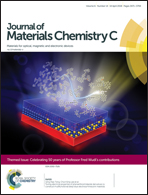Abstract
We report the synthesis and characterization of a non-liquid crystalline material, 2-phenylchrysene (Ph-CHR), and a liquid crystalline material, 2-(4-dodecyl phenyl)chrysene (C12-Ph-CHR), and discuss their organic thin-film transistor (OTFT) device performances. The concept of designing chrysene derivatives is derived from the similar electronic structure of chrysene and [1]benzothieno[3,2-b][1]benzothiophene (BTBT), which is a very famous core for organic semiconductors. OTFTs, based on Ph-CHR and C12-Ph-CHR, are fabricated by vacuum-deposition on octyltrichlorosilane (OTS(8)) treated Si/SiO2 substrates. Our experimental results show that OTFTs based on Ph-CHR possess higher mobility than OTFTs based on BTBT derivative 2-phenyl[1]benzothieno[3,2-b][1]benzothiophene (Ph-BTBT). The liquid crystalline material C12-Ph-CHR achieves the highest carrier mobility of up to 3.07 cm2 V−1 s−1 with an on/off ratio of 3.3 × 106 for polycrystalline organic thin-film transistors in ambient air. The results indicate that the chrysene derivative C12-Ph-CHR is a promising candidate for applications in electronic devices.

- This article is part of the themed collection: Celebrating 50 years of Professor Fred Wudl’s contributions to the field of organic semiconductors


 Please wait while we load your content...
Please wait while we load your content...